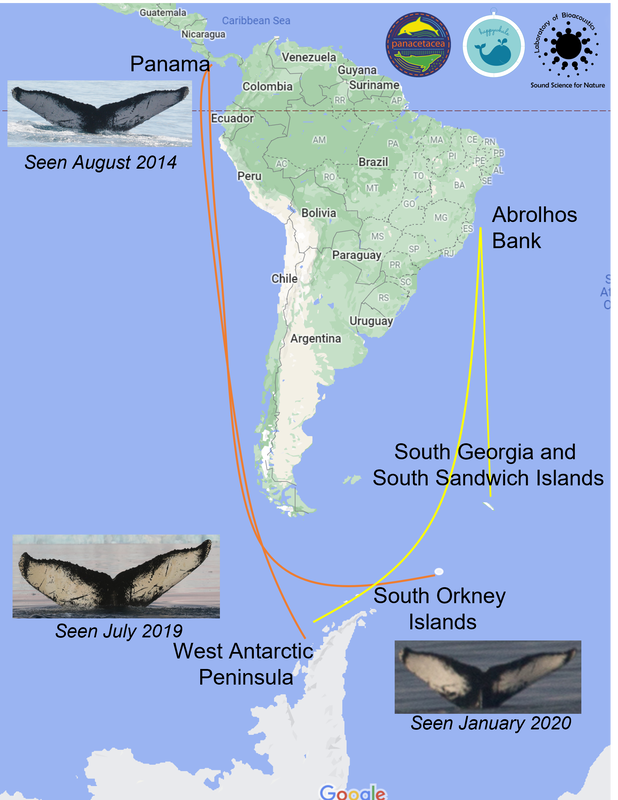by Kristin Rasmussen
We continue to get exciting and unexpected results from our Panama photo-identification project! Since 2002, we have photo-identified 875 individual whales in the Gulf of Chiriqui. These photos were recently a part of a large collaborative study led by our colleagues from Brazil. This study discovered the first time that whales from Panama have been sighted in the South Orkney Islands, a feeding area east of the Antarctic Peninsula!
The whales we normally see off the Pacific coast of Panama, Colombia, and Ecuador during the breeding season, known as “Breeding Stock G,” usually travel to feeding areas off southern Chile and the western Antarctic Peninsula. In contrast, whales breeding in the Atlantic off Brazil, known as “Breeding Stock A,” are known to travel to feeding areas off South Georgia and the South Sandwich Islands, all areas to the east of the Antarctic Peninsula. But the new study not only discovered Panama whales off the South Orkney Islands; it turns out that whales that breed off Brazil were also sighted in the western Antarctic Peninsula feeding area, traditionally used by Stock G. This gives us new insight into how two different humpback whale populations in the Southern Hemisphere appear to be mixing with each other in recent times, and why this mixing may be occurring.
This study used the online platform Happywhale, a collaboration of researchers and citizen scientists who submit photos of whales seen throughout the world. Happywhale features a sophisticated automated computer algorithm that we used to compare photos of whales seen off Central and South America with whales seen throughout the Southern Hemisphere, as well as with Happywhale’s entire worldwide catalog – in total 47,122 individual whales! The algorithm found eight whales from Stocks A and G that had also been seen outside of their traditional feeding areas. Of these, six Stock-A whales had been seen off the western Antarctic Peninsula, and two Stock-G whales had been seen off the South Orkney Islands. Interestingly, one of the Stock-G whales was seen in feeding areas off the western Antarctic Peninsula in 2019, and then just six months later was sighted off the South Orkneys, suggesting that this whale did not undertake a winter migration that year but that it remained in the Antarctic. The fact that Stock-G whales are being seen so far east near traditional Stock-A feeding areas, and that Stock-A whales are being seen in Stock-G feeding areas, tells us that these populations are mixing more than we had previously thought. In fact, since this study was completed, we found one more whale that had been seen in both the South Orkneys (in January 2021) and Panama (in 2008 and 2018).
There are several factors that may be prompting these whales to expand their range. Both Stock-A and Stock-G populations are growing after being drastically reduced by whaling. As the populations grow, their distributions are likely to expand into new areas or previously occupied areas before they were hunted. Additionally, the amount of prey available in a given year influences whale distribution. The main food source for humpbacks feeding off Antarctica is krill, which relies on sea ice in its reproductive stage. As the climate changes and ocean temperatures warm, sea ice coverage in Antarctica fluctuates, directly impacting the amount of krill available. Perhaps whales are seeking out new areas to find sufficient krill resources depending on ice coverage in the previous winter. Another possibility is simply because of increased research efforts and tourism activities in these remote regions, more researchers and citizen scientists have been taking photos in recent years. This may increase the likelihood of finding matches between regions.
Large collaborative studies like this are crucial in monitoring these populations as they recover from whaling but are now starting to feel the impacts of climate change. Our years of effort and data collection in Panama are helping address these important questions!

Special thanks to Renata Sousa-Lima and her team at the Laboratory of Bioacoustics, Federal University of Rio Grande do Norte, Brazil, for leading this multi-national effort.


